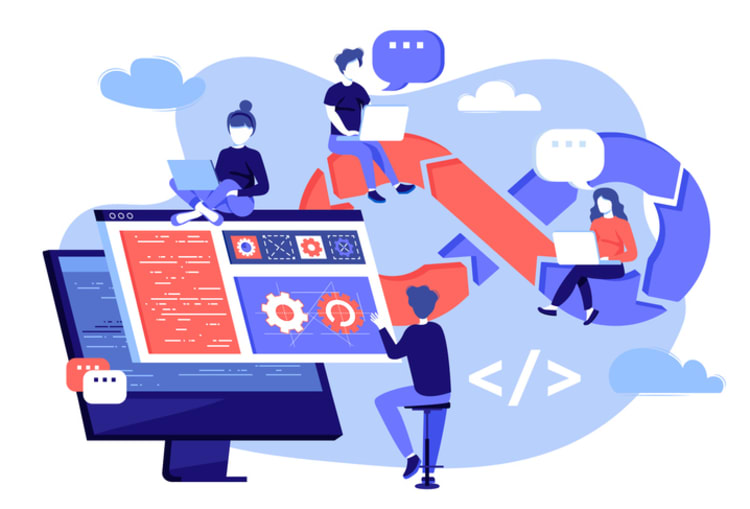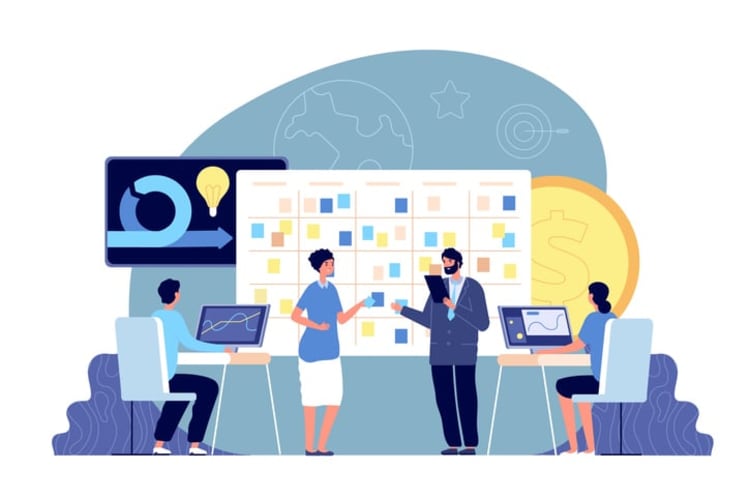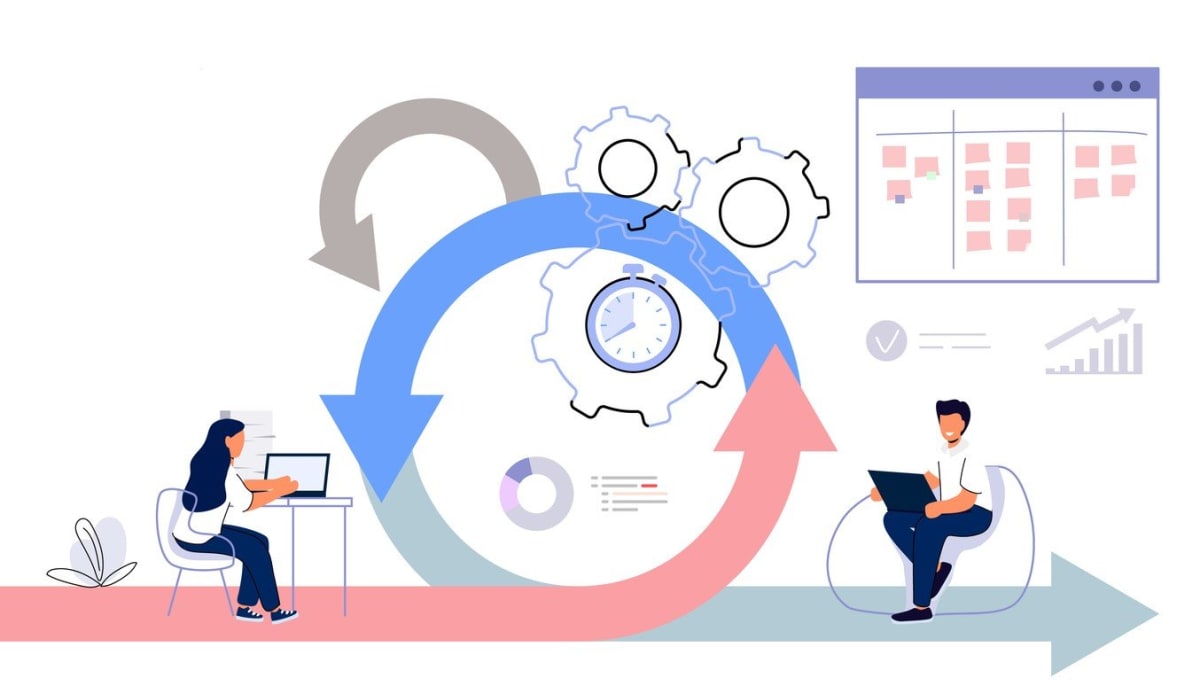Imagine you’re a project manager embarking on a new software development project. You’ve heard of Agile and Scrum methodologies, but you’re not quite sure which one to choose. Does one offer more benefits than the other? How do they differ, and in what ways are they similar? Understanding these differences and similarities is crucial to selecting the right project management approach for your team, especially when considering “agile vs scrum”.
In this blog post, we’ll dive into the world of Agile and Scrum, exploring their principles, roles, and processes. We’ll also examine the key differences and similarities between the two methodologies in the context of agile vs scrum, so you can make an informed decision on which approach best fits your project’s needs.
Short Summary
- Agile and Scrum share common goals, principles & values such as customer satisfaction, collaboration and delivering value efficiently.
- Agile offers flexibility while Scrum provides structure. Both can be tailored to the needs of a project or team.
- Factors such as size/complexity of project, experience/capabilities of team & client involvement should be considered when selecting between them.
Understanding agile methodology

Agile methodology is an approach to agile project management that emphasizes adaptability, collaboration, and customer satisfaction. It is rooted in the Agile Manifesto, which outlines its core principles, and aims to provide a flexible, iterative, and incremental approach to software development. By adopting this project management philosophy, Agile allows teams to respond to changes quickly and effectively, making it an excellent choice for projects with unpredictable or rapidly evolving requirements.
Scrum is a popular framework for implementing Agile principles, often referred to as an Agile methodology subset. It provides a structured environment for cross-functional teams to work together, focusing on delivering valuable software through incremental processes within a larger framework.
Other Agile methodologies include Kanban and Extreme Programming (XP), each offering unique approaches to achieving the same overall goals as Agile.
Agile principles
At the heart of Agile methodology are its principles, which prioritize:
- Customer satisfaction
- Welcoming changing requirements
- Regular delivery of working software
- Collaboration between developers and business stakeholders
These principles guide Agile teams in their pursuit of delivering high-quality software that addresses customers’ most pressing needs as quickly as possible.
Scrum project management is an excellent example of the practical application of Agile principles. By organizing tasks and prioritizing them during sprint planning, Scrum teams can ensure they’re always working on the most important features, delivering value to customers, and adapting to changes as they arise. This approach helps increase project efficiency and ensures that projects remain aligned with customer needs.
Agile software development
Agile software development focuses on iterative progress, continuous feedback, and the delivery of small increments of the project throughout the process. This approach allows development teams to remain flexible and responsive to rapidly changing requirements while still maintaining a high level of quality and efficiency.
Scrum-based development projects are a prime example of Agile in action. They consist of three main components: product backlogs, sprint backlogs, and sprint goals. Through these components, Scrum teams can effectively manage their work, prioritize tasks, and ensure they’re always making progress towards their goals.
This approach helps teams effectively apply Agile principles and practices, delivering value to customers and continuously improving their agile processes.
Delving into scrum methodology

Scrum methodology is a specific framework designed to implement Agile principles in a structured and organized manner. It provides a set of roles, rituals, and artifacts that help teams manage their work and deliver software in an efficient and timely manner. The Scrum framework enables cross-functional teams to work together towards a common goal, delivering high-quality software that meets customer needs.
Some of the benefits of using Scrum include:
- Increased responsiveness to customer feedback
- Reduced development costs
- Improved job satisfaction
- More immediate returns on investment
By focusing on customer requirements and prioritizing tasks during sprint planning, Scrum teams can ensure they’re always working on the most critical features and delivering value to their customers.
Scrum roles
Scrum prescribes three main roles: Product Owner, Scrum Master, and Scrum Team. The Product Owner is responsible for managing the product backlog, setting the vision for the product, and ensuring the team focuses on the most critical tasks. They work closely with stakeholders to understand their needs and prioritize work accordingly.
The responsibilities of a Scrum Master include:
- Ensuring the success of each project
- Keeping the team on track
- Addressing and resolving any issues that arise
- Ensuring the team follows Scrum methodologies
- Enforcing deadlines
The Scrum Team, on the other hand, is responsible for executing the tasks in the product backlog. This self-organizing team evaluates the amount of work that can be accomplished in each sprint and adjusts its approach accordingly.
Scrum process
The Scrum process involves planning, executing, and reviewing sprints, as well as holding daily stand-up meetings and retrospectives. During a sprint, the team works on a set of tasks from the product backlog, aiming to complete them within a designated timeframe. Daily stand-up meetings allow the team to discuss progress, address any obstacles, and ensure everyone is on the same page.
After each sprint, the team conducts a review and retrospective, assessing the work completed and identifying opportunities for improvement. This iterative approach allows Scrum teams to continuously refine their processes, adapt to changing requirements, and deliver high-quality software that meets customer needs.
Key differences between agile and scrum

When comparing agile vs Scrum, it’s important to note that while both share some common goals and principles, there are key differences between the two methodologies. One of the main distinctions lies in their approach towards flexibility and structure. Agile is a more adaptable methodology that focuses on adaptive, concurrent workflows, whereas Scrum provides a structured framework for project management, helping teams organize their work into short development cycles known as sprints.
Another significant difference between Agile and Scrum is their scope of application. Agile is a comprehensive project management methodology that can be applied to various methodologies, while Scrum is a specific implementation of Agile principles. This means that Agile can be used in conjunction with other frameworks, such as Kanban and Extreme Programming, while Scrum is a standalone framework for implementing Agile practices.
Flexibility vs. structure
Agile methodology is known for its flexibility and adaptability. It encourages teams to continually refine their processes, improve collaboration, and adapt to changing requirements. This level of flexibility allows Agile teams to respond quickly to customer feedback and deliver high-quality software that meets their ever-changing needs.
On the other hand, Scrum offers a more structured approach to project management. By providing a clear framework with defined roles, rituals, and artifacts, Scrum helps teams stay organized and focused on their goals. This structure ensures that teams can efficiently manage their work, adapt to change, and deliver valuable software in a timely manner.
Scope of application
Agile methodology can be applied to various methodologies, making it a versatile approach for project management. It can be used in conjunction with other Agile frameworks, such as Kanban and Extreme Programming, to create a tailored project management approach that suits the unique needs of a team or project.
In contrast, Scrum is a specific implementation of Agile principles, providing a structured framework for project management. While it can be used in a wide variety of industries and project types, it is important to remember that Scrum is just one of many Agile methodologies available. When selecting a methodology for your project, it is essential to consider the specific requirements and constraints of the project, as well as the experience and capabilities of your team.
Similarities between agile and scrum

Despite their differences, Agile and Scrum share several similarities, including their emphasis on delivering software regularly, utilizing collaborative iterations, and focusing on customer satisfaction. Both methodologies strive to improve the product development process and promote similar behavioral changes, such as increased collaboration, transparency, and adaptability.
Another key similarity between Agile and Scrum is their iterative approach to project management. By breaking down projects into smaller, manageable components, both methodologies enable rapid feedback and adaptation to changing requirements. This iterative process helps teams maintain a high level of quality and efficiency, ensuring that projects remain aligned with customer needs and expectations.
Shared values
Agile and Scrum share a number of core values, such as:
- Collaboration
- Delivering business value in a timely manner
- Focusing on the outcome rather than the output
- Encouraging regular releases
These shared values help guide both methodologies in their pursuit of delivering high-quality software that meets customer needs and expectations.
Both Agile and Scrum also emphasize the importance of people in the development process. By fostering a culture of collaboration, communication, and continuous improvement, Agile and Scrum teams can ensure that projects remain on track and deliver value to customers. This shared focus on people and collaboration helps create a positive and productive work environment, ultimately leading to better project outcomes.
Iterative approach
The iterative approach is a fundamental aspect of both Agile and Scrum methodologies. By dividing projects into smaller components and repeating certain elements of the methodology until a desirable outcome is achieved, Agile and Scrum teams can effectively manage their work, prioritize tasks, and ensure they’re always making progress towards their goals.
This iterative approach allows Agile and Scrum teams to continuously refine their processes, adapt to changing requirements, and deliver high-quality software that meets customer needs. By focusing on iterative development, both methodologies can successfully navigate the complexities of modern software development projects, ultimately delivering value to customers and stakeholders through the effective use of a software development methodology.
Choosing the right methodology: agile or scrum?

When it comes to choosing the right methodology for your project, it’s essential to consider factors such as the size and complexity of the project, the level of client involvement, and the need for flexibility and adaptability. Both Agile and Scrum can help teams adapt to change and deliver high-quality products, but the specific methodology chosen should align with the project’s unique needs and constraints.
For example, Scrum may be more suitable for complex projects in rapidly changing environments, while Agile may be more appropriate for projects that require a high degree of customer involvement and flexibility. By carefully considering the specific requirements of your project and the capabilities of your team, you can choose the right methodology to ensure project success.
Factors to consider
When selecting between Agile and Scrum, it’s important to evaluate factors such as the size and complexity of the project, as well as the experience and capabilities of your team. For larger, more complex projects, Scrum may be a better fit, as it provides a structured framework that can help teams stay organized and focused on their goals.
The level of client involvement is another crucial factor to consider. Agile methodologies tend to be more flexible and adaptable, allowing for a higher degree of collaboration with clients and stakeholders. If your project requires frequent input from clients and the ability to adjust to changing requirements, Agile may be the better choice.
Adapting to change
Both Agile and Scrum methodologies are designed to be flexible and adaptable, allowing teams to quickly respond to changes in project requirements and customer feedback. By focusing on collaboration, regular iteration, and continuous improvement, Agile and Scrum teams can effectively manage change and deliver high-quality software that meets customer needs.
To facilitate adaptation to change when using Agile and Scrum, it’s important to provide your development team with sufficient time to review upcoming changes, collaborate, and adjust their approach as needed. Ensuring that there’s a streamlined and efficient change process in place will help your team adapt more effectively, ultimately leading to better project outcomes and customer satisfaction.
Real-world examples of agile and scrum implementation

Agile and Scrum methodologies have been successfully implemented in various industries and organizations around the world. For example, in the software development industry, companies like Spotify and IBM have adopted Agile and Scrum practices to deliver high-quality software products and improve their development processes.
Outside of software development, Agile principles have also been applied to other fields, such as legal affairs. Kate Sullivan, a corporate lawyer on the Lonely Planet legal team, has implemented Agile to revolutionize the service delivery of their legal affairs. They utilize the following Agile practices:
- Whiteboards
- Cards
- Morning stand-up meetings
- Weekly iterations to prioritize tasks and improve collaboration
These real-world examples showcase the versatility and effectiveness of Agile and Scrum methodologies in driving project success.
Alternatives to agile and scrum
While Agile and Scrum are popular methodologies for project management, there are also other alternatives that may better suit your project’s needs. Traditional project management methodologies, such as Waterfall, focus on planning, predictability, and adhering to a strict plan to meet project requirements. Waterfall follows a linear process, dividing the project into separate stages, including:
- Planning
- Design
- Development
- Testing
- Deployment
Each stage is completed before the next one begins.
Other Agile methodologies, such as Kanban and Extreme Programming, offer unique approaches to achieving project goals. Kanban emphasizes visualizing the workflow and limiting work in progress, while Extreme Programming focuses on customer satisfaction, communication, and simplicity in software development.
Understanding the strengths and weaknesses of each methodology can help you choose the right approach for your project.
Summary
In conclusion, understanding the differences and similarities between Agile and Scrum methodologies is crucial for selecting the right project management approach for your team. Agile is a flexible, adaptable methodology that can be applied to various project types, while Scrum provides a structured framework for project management, focusing on delivering value through iterative and incremental work.
When choosing between Agile and Scrum, it’s important to consider factors such as the size and complexity of the project, the level of client involvement, and the need for flexibility and adaptability. By carefully evaluating these factors and aligning your chosen methodology with your project’s unique needs and constraints, you can ensure project success and deliver high-quality products that meet customer expectations.
Frequently Asked Questions
Agile is a philosophy of successful software delivery, whereas Scrum is a proven methodology for software development teams to follow.
Yes, Scrum is a version of Agile, as it is a subset of Agile and a lightweight process framework for agile development.
Agile is a mindset or way of thinking in software development which focuses on continuous improvement and customer value delivery.
Scrum is an Agile process within this philosophy, which involves breaking projects down into small increments (known as “sprints”) and delivering business value in the shortest possible time.
Scrum came before Agile, being established in 1993 compared to the Agile Manifesto in 2001, and is thus an important part of Agile methodology.
Yes, Agile can be used for a variety of projects beyond software development, including legal affairs and manufacturing.





